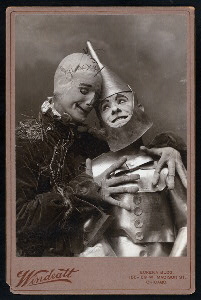The Marvelous Land of Oz was published in 1904, four years after The Wonderful Wizard of Oz, and two years after Baum's highly successful stage version of the latter. As such, there are definitely elements of this book that seem to be written with an eye towards the stage. The book is notable among Baum's fourteen original Oz books as one of the few to have a male protagonist, and the only one not to feature Dorothy at all.
This book is also notable for bringing on board a new illustrator. Apparently, Baum and W. W. Denslow, the illustrator of the original, argued over royalties to that 1902 stage version. Denslow had designed the sets and costumes and was co-holder of the copyright of the book, and thus thought he deserved an equal share with Baum and the music composer. Baum disagreed and decided not to work with him again. Don't feel too bad for Denslow, though. The royalties he did receive from the book and the musical were enough for him to purchase an island in Bermuda and declare himself King Denslow I. (Though it seems he sold it again by 1908. So much for the dynasty.)
Thus, instead of Denslow, this book is illustrated by John R. Neill, who would go on to illustrate more than forty different Oz books, including all of the rest of the "Famous Forty" canonical Oz books, minus four that came out after his death in 1943 but including three that he wrote himself. Neill's style rather obviously became the "definitive" style that at least influenced all other Oz illustrators who followed, if they didn't mimic him outright.
Now, while Denslow's illustrations were all in color (even if it was usually only one or two colors), Neill's illustrations here are mostly line drawings, with sixteen full-color plates throughout. The quantity of illustrations, though, remains quite large. AS such, much with the last book, I won't be time-tagging them, as they come a little too thick and fast.
The color plates here come from Old Book Art, the full-page black and white illustrations come from the facsimile of the first edition at OpenLibrary.org, and the remaining line drawings are all from Classics Illustrated (but no, not that Classics Illustrated.) And since this is the first installment, I've included the preliminary illustrations:
Above is the copyright page, showing play posters being pasted up, presumably as a nod to the stage version.
See more after the jump!
Here's the author's note, claiming that a real little "Dorothy" is responsible for the publication of this sequel.
And here we have a dedication to David C. Montgomery and Fred A. Stone, comedians who played the Tin Woodman and the Scarecrow in the musical to great public acclaim. Those drawings are pretty good depictions of what they looked like in their costumes:
...eesh.
Here we have the table of contents, along with a depiction of our major players. Well, most of them. The first three we meet in this installment, the next two we already know, and the last two we'll meet soon enough. And with that, we start on the story proper:
Okay, after this one random preliminary illustration. Did I mention how popular the Scarecrow and Tin Woodman were in the stage version?
You'll note here that, as with the Denslow illustrations, Neill's color illustrations are coded to the part of Oz we're in at the moment. Right now, we're in Gillikin Country in the north of Oz, the only section we didn't visit in the original. Note also that Tip later describes that everything in the country is purple: not just painted things like fences and houses, but grass and mud as well, and that this runs true for the other countries as well. This runs a little counter to descriptions in the original. Baum was not... great on detail continuity. More on that in later books.
Those of you familiar with the 1985 movie Return to Oz will recognize the good Mr. Pumpkinhead, though it doesn't depict his origin. He's one of several elements that were lifted from this book for the movie, which also includes good old Mombi here. She may be a little different than you remember, though: there, she's a beautiful young woman who switches heads around when she gets bored with them. Here, she's a wicked old witch. They took Mombi's name and applied it to a character we'll meet in the next book, which is where most of the movie actually came from.
I don't think you can quite make it out here, but that book hanging up in the right-hand corner is titled Og-Hok Gibbery Gub-Gub Dreams. I haven't the faintest idea what that means, if anything.
By the way, does it occur to anyone else just how incredibly DUMB Mombi is here? "Here, let me explain to you exactly how I'm basically going to kill you, but oops! We have to wait until morning. Well, goodnight! Be sure not to run away or anything other the next several hours I'll be asleep! No I'm not going to bother locking you in anywhere, I trust you!"
If you would like to read along, the text can be found at Project Gutenberg with no pictures, and a fully illustrated facsimile of the first edition can be found at Open Library. No reading ahead, though!






















No comments:
Post a Comment